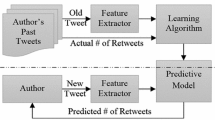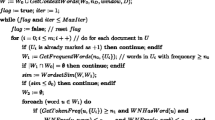Abstract
Social networks are a thriving source of information and applications are pervasive. Twitter has recently experienced a significant change in its essence with the doubling of the number of maximum allowed characters from 140 to 280. In this work we study the changes that come from such modification when learning systems are in place. Results on real datasets of both settings show that transferring models between both scenarios may need special treatment, as bigger tweets are harder to classify, making such dynamic environments even more challenging.
Access this chapter
Tax calculation will be finalised at checkout
Purchases are for personal use only
Similar content being viewed by others
References
Merriam-Webster’s dictionary, October 2012
Barnard, S.: Twitter: more than 140 characters. In: Palgrave Macmillan (ed.) Citizens at the Gates, Chap. 2, pp. 13–31. Springer (2018)
Chang, H.C.: A new perspective on Twitter hashtag use: diffusion of innovation theory. In: Proceedings of the 73rd Annual Meeting on Navigating Streams in an Information Ecosystem, pp. 85:1–85:4 (2010)
Costa, J., Silva, C., Antunes, M., Ribeiro, B.: On using crowdsourcing and active learning to improve classification performance. In: Proceedings of the 11th International Conference on Intelligent Systems Design and Applications, pp. 469–474 (2011)
Costa, J., Silva, C., Antunes, M., Ribeiro, B.: Defining semantic meta-hashtags for Twitter classification. In: Proceedings of the 11th International Conference on Adaptive and Natural Computing Algorithms, pp. 226–235 (2013)
Huang, J., Thornton, K.M., Efthimiadis, E.N.: Conversational tagging in Twitter. In: Proceedings of the 21st ACM Conference on Hypertext and Hypermedia, pp. 173–178 (2010)
Joachims, T.: Learning Text Classifiers with Support Vector Machines (2002)
Johnson, S.: How Twitter will change the way we live. Time Mag. 173, 23–32 (2009)
van Rijsbergen, C.: Information Retrieval (1979)
Rosell-Aguilar, F.: Twitter as a formal and informal language learning tool: from potential to evidence. In: Rosell-Aguilar, F., Tita Beaven, M.F.G. (eds.) Innovative Language Teaching and Learning at University: Integrating Informal Language into Formal Language Education, Chap. 11, pp. 99–106. Research-publishing.net (2018)
Tong, S., Koller, D.: Support vector machine active learning with applications to text classification. J. Mach. Learn. Res. 2, 45–66 (2002)
Tsur, O., Rappoport, A.: What’s in a hashtag? Content based prediction of the spread of ideas in microblogging communities. In: Proceedings of the 5th International Conference on Web Search and Data Mining, pp. 643–652 (2012)
Vapnik, V.: The Nature of Statistical Learning Theory (1999)
Williams, S., Terra, M., Warwick, C.: What do people study when they study Twitter? Classifying Twitter related academic papers. J. Doc. 69(3), 384–410 (2013)
Yang, L., Sun, T., Zhang, M., Mei, Q.: We know what @you #tag: does the dual role affect hashtag adoption? In: Proceedings of the 21st International Conference on World Wide Web, pp. 261–270 (2012)
Zappavigna, M.: Ambient affiliation: a linguistic perspective on Twitter. New Media Soc. 13(5), 788–806 (2011)
Author information
Authors and Affiliations
Corresponding author
Editor information
Editors and Affiliations
Rights and permissions
Copyright information
© 2020 Springer Nature Switzerland AG
About this paper
Cite this paper
Costa, J., Silva, C., Ribeiro, B. (2020). Learning in Twitter Streams with 280 Character Tweets. In: Madureira, A., Abraham, A., Gandhi, N., Silva, C., Antunes, M. (eds) Proceedings of the Tenth International Conference on Soft Computing and Pattern Recognition (SoCPaR 2018). SoCPaR 2018. Advances in Intelligent Systems and Computing, vol 942. Springer, Cham. https://doi.org/10.1007/978-3-030-17065-3_18
Download citation
DOI: https://doi.org/10.1007/978-3-030-17065-3_18
Published:
Publisher Name: Springer, Cham
Print ISBN: 978-3-030-17064-6
Online ISBN: 978-3-030-17065-3
eBook Packages: Intelligent Technologies and RoboticsIntelligent Technologies and Robotics (R0)




